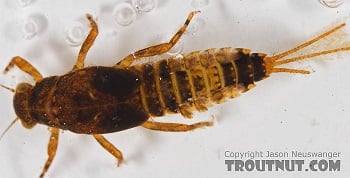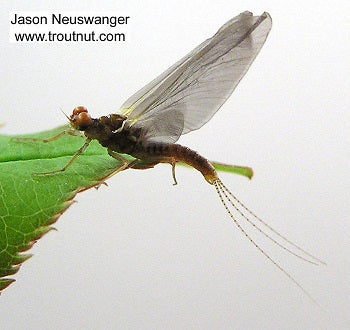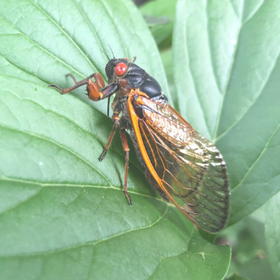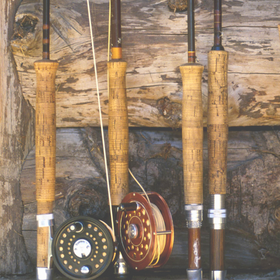Not that we have that solved lets talk why we as fly fishers care. The PMD is a very important hatch in many places, particularly in Western North America, but it appears virtually everywhere. There are also many closely related hatches that are also referred to as PMD, and on many rivers these secondary hatches can make the 'PMD' hatch last well into October. But for most purposes the PMD hatch starts in May in the east and June in the west, lasting at least throughout the summer.
They hatch primarily mid-morning after the sun has heated up the air, and typically hatch through mid-afternoon. Fishing PMD's require very little in uncomfortable fishing, in fact for the fair weather fisher these are your best friends.
 - Pale Morning Dun Nymph (photo: www.troutnut.com)
- Pale Morning Dun Nymph (photo: www.troutnut.com)
Depending on the exact sub-species you may be fishing nymphs can be found in either fast or slow water, they are commonly imitated with the work horse nymphs Gold Ribbed Hare's Ear or Pheasant Tails. Light Cahill Nymph also works, as the nymphs can be cream or olive colored, often times with different coloration on the abdomen.
Because the PMD is a heavily fished hatch, highly pressured streams can find you casting to irritatingly selective fish. Sometimes just keying on the emergers, sometimes just the duns, sometimes just the cripples and sometimes just the spinners. Careful observation can give clues as to fish behavior, slurping action right under the surface shows emerger focus, while slapping at drifting duns means they are hitting the adults before take off. If you see sporadic takes in slow eddies or pools, particularly downstream from some frenetic hatching think cripples. Importance of spinner falls vary from location to location, but on rivers where PMD is king, or at least high prince the falls also are worth fishing.
 - Pale Morning Dun (photo: www.troutnut.com)
- Pale Morning Dun (photo: www.troutnut.com)
The color of the hatching insects can change from hour to hour, but primarily they will be cream with some olive or yellow tones. There may also be two or more sub-species coming off at the same time. Don't be afraid to throw different flies at them, If your first offering is not doing the trick. Besides PMD, try Parachute PMD, Sulphur Dun, Light Cahill. If you find them keying on emergers (very common) Try Flymph, Light Cahill Wet Fly, Foam Post Emerger, or our personal favorite Klinkhammer Olive/Yellow. Cripples can be imitated with PMD Cripples, but also Sparkle Dun PMD.
 - Pale Morning Dun Spinner (photo: www.troutnut.com)
- Pale Morning Dun Spinner (photo: www.troutnut.com)
In short, carry everything this side of an Adams, and don't be afraid to exhaust your ammo of flies. Presentation can be everything during this time of year, as fish are already well fed, heavily pursued, and the water is clear, use the lightest tippets you feel comfortable with, and wade like a heron, no time to splat those size 13s.
It is not uncommon for fish to turn off the feed after hooking a few. During these times either select, a new section or just give it a rest, observation will tell you when they turn back on. Trying a different approach or imitation, can often do the trick as well.



